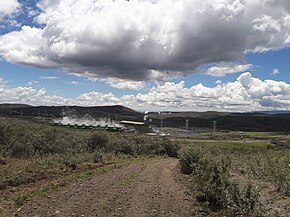This article needs additional citations for verification. (March 2019) |

Most of Kenya's electricity is generated by renewable energy sources.[1] Access to reliable, affordable, and sustainable energy is one of the 17 main goals of the United Nations’ Sustainable Development Goals.[2] Development of the energy sector is also critical to help Kenya achieve the goals in Kenya Vision 2030 to become a newly industrializing, middle-income country. With an installed power capacity of 2,819 MW, Kenya currently generates 826 MW hydroelectric power, 828 geothermal power, 749 MW thermal power, 331 MW wind power, and the rest from solar and biomass sources.[3] Kenya is the largest geothermal energy producer in Africa and also has the largest wind farm on the continent (Lake Turkana Wind Power Project).[4][5] In March 2011, Kenya opened Africa's first carbon exchange to promote investments in renewable energy projects.[6] Kenya has also been selected as a pilot country under the Scaling-Up Renewable Energy Programmes in Low Income Countries Programme to increase deployment of renewable energy solutions in low-income countries.[7] Despite significant strides in renewable energy development, about a quarter of the Kenyan population still lacks access to electricity, necessitating policy changes to diversify the energy generation mix and promote public-private partnerships for financing renewable energy projects.[8][9]
- ^ International Trade Administration, International Trade Administration (2022-08-19). "Energy-Electrical Power Systems". trade.gov. Retrieved October 11, 2022.
- ^ Martin. "Energy". United Nations Sustainable Development. Retrieved 2022-04-21.
- ^ "Power Africa in Kenya | Power Africa | U.S. Agency for International Development". www.usaid.gov. 2022-02-18. Retrieved 2022-04-21.
- ^ "Kenya the largest geothermal energy producer in Africa starts construction of new plant". Construction Review Online. 2018-12-06. Retrieved 2022-04-21.
- ^ "The largest wind power plant in Africa has opened in Kenya". World Economic Forum. 26 July 2019. Retrieved 2022-04-21.
- ^ Gachenge, Beatrice (24 March 2011). "Kenya opens Africa's first carbon exchange". reuters.com. Retrieved 13 April 2018.
- ^ "Africa Energy Futures: Kenya | | Insights | DLA Piper Global Law Firm". DLA Piper. Retrieved 2022-04-21.
- ^ "Kenya - Electrical Power Systems | Privacy Shield". www.privacyshield.gov. Retrieved 2022-04-21.
- ^ Cite error: The named reference
:2was invoked but never defined (see the help page).